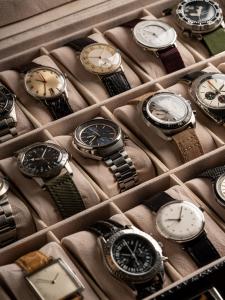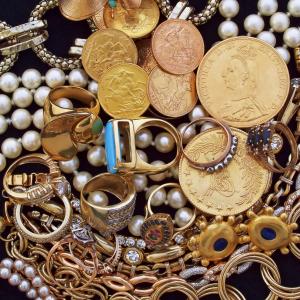From Pawnshops to Portfolios: Turning Collectibles into Reliable Sources of Income

A curated collection of vintage timepieces—once pawnshop staples, now redefined as portfolio-worthy assets that combine history, craftsmanship, and financial growth potential.
How everyday treasures—from coins to watches—are becoming serious income-generating assets for modern investors.
“Collectibles have evolved from being objects of sentiment or necessity-driven pawnshop trades into strategic investment tools,” says Avi-Meir Zaslavsky, founder of 999Precious, a global platform dedicated to the education and trade of precious and collectible assets. “We are seeing a profound cultural and financial shift in how people perceive the value of what they own.”
For centuries, pawnshops served as the primary marketplace for collectibles. People would pawn jewelry, heirlooms, or antiques in exchange for immediate cash. While still a staple in many communities, pawnshops represented the short-term view of collectibles: quick liquidity, often at undervalued prices.
Today, that narrative has flipped. Collectibles are increasingly being held, traded, and curated with the same strategic outlook once reserved for stocks and bonds. Wealth managers, auction houses, and even fintech platforms are offering clients access to collectible markets.
“Where pawnshops once set the tone for what collectibles were worth, the rise of global marketplaces and digital trading platforms has empowered owners to maximize value,” Zaslavsky explains. “Collectors are no longer selling in distress—they’re investing with intent.”
Several factors are driving this transformation:
1. Rising Asset Diversification Needs – Economic uncertainty and inflation have led investors to seek alternative assets. Collectibles, with their limited supply and cultural value, provide a hedge against market volatility.
2. Cultural & Emotional Value – Unlike traditional assets, collectibles carry personal stories, artistry, and heritage. This emotional dimension adds resilience, as demand persists even in downturns.
3. Global Accessibility – Digital platforms and international auctions make it easier than ever to buy, sell, and authenticate collectibles across borders.
4. Generational Shifts – Millennials and Gen Z are embracing collectibles not just as passions but as wealth-building strategies, especially in categories like sneakers, luxury watches, and contemporary art.
“People are realizing that their collections can work for them financially,” says Zaslavsky. “It’s no longer just about owning a beautiful watch or a rare coin. It’s about understanding how that asset can appreciate over time and provide income.”
While collectibles vary widely, certain categories have emerged as reliable performers:
-Watches: Vintage Rolex, Omega, and Patek Philippe pieces often appreciate steadily, with limited editions commanding premiums.
- Jewelry: Signed pieces from Cartier, Van Cleef & Arpels, and Bulgari continue to rise in value.
- Coins & Bullion: Rare numismatic coins and gold/silver bullion combine intrinsic and collectible value.
- Art & Photography: Contemporary artists and limited-edition prints are popular with younger buyers.
- Luxury Fashion: Hermès Birkin bags and limited sneaker drops have proven to outperform some traditional investments.
“Watches and jewelry are especially strong right now,” Zaslavsky notes. “Not only do they hold intrinsic material value, but they also carry cultural prestige. That combination makes them highly liquid and attractive to both collectors and investors.”
The transformation from pawnshop collateral to portfolio centerpiece reflects a broader change in mindset. Investors are learning to balance emotional attachment with financial discipline.
For example, someone who once pawned a family ring for emergency cash may now research its provenance, obtain certification, and sell it at an auction for multiples of its pawn value. Similarly, sneaker enthusiasts who once bought limited editions for style now resell them strategically, building six-figure businesses.
“This is about education as much as opportunity,” emphasizes Zaslavsky. “At 999Precious, we work to show people how to properly store, insure, and evaluate their collectibles. With the right knowledge, a collection becomes not just a passion project but a financial strategy.”
Of course, not every collectible guarantees profit. The market carries risks, from counterfeits and fluctuating demand to liquidity challenges in niche categories. That’s why expertise and authentication are critical.
“Collectors must remember: not every old item is valuable,” Zaslavsky cautions. “Provenance, condition, rarity, and brand recognition are the factors that matter most. We always advise clients to buy what they love first—then consider the investment potential second.”
He adds that just like stocks, collectibles require patience. “This is not a get-rich-quick game. It’s about holding for the long term, understanding cycles, and making informed decisions.”
Digital innovation has been a game changer in moving collectibles into the mainstream investment world. Blockchain-based certificates of authenticity, NFT tie-ins for digital art, and global e-commerce platforms have created unprecedented transparency and accessibility.
“Technology has helped eliminate much of the uncertainty that once plagued the collectibles market,” says Zaslavsky. “With digital certificates, AI-based valuation tools, and global marketplaces, buyers and sellers can operate with far greater confidence.”
Even traditional auction houses like Christie’s and Sotheby’s now offer live-streamed digital auctions, attracting younger, tech-savvy audiences worldwide.
While financial gains are enticing, many investors emphasize that collectibles deliver something traditional assets cannot: joy. A stock certificate doesn’t turn heads, but a rare timepiece on the wrist or a painting on the wall does.
“Collectibles generate what I like to call the ‘emotional dividend,’” Zaslavsky says with a smile. “They enrich your life even as they appreciate in value. That dual return—emotional and financial—is why so many people are moving their assets from pawnshops to portfolios.”
As global markets continue to evolve, experts predict that collectibles will remain a key growth sector. Younger investors are likely to broaden the definition of collectibles even further, embracing digital-native assets like NFTs alongside traditional categories.
For Zaslavsky, the future is about accessibility and education. “Our mission at 999Precious is to help people recognize the potential in what they already own, as well as to guide them toward smart acquisitions. Collectibles should be celebrated as both treasures and tools for financial security.”
The journey from pawnshop counters to curated portfolios reflects a fundamental cultural and financial shift. Collectibles are no longer just sentimental heirlooms or emergency cash resources—they’re legitimate, reliable sources of income.
“Every collectible tells a story,” concludes Zaslavsky. “And when you combine those stories with strategy, you create not just memories but wealth. That’s the true power of this new era of collecting.”
Avi-Meir Zaslavsky
999Precious
info@999Precious.com
Visit us on social media:
LinkedIn
Instagram
Facebook
X
Legal Disclaimer:
EIN Presswire provides this news content "as is" without warranty of any kind. We do not accept any responsibility or liability for the accuracy, content, images, videos, licenses, completeness, legality, or reliability of the information contained in this article. If you have any complaints or copyright issues related to this article, kindly contact the author above.


